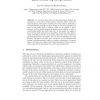Free Online Productivity Tools
i2Speak
i2Symbol
i2OCR
iTex2Img
iWeb2Print
iWeb2Shot
i2Type
iPdf2Split
iPdf2Merge
i2Bopomofo
i2Arabic
i2Style
i2Image
i2PDF
iLatex2Rtf
Sci2ools
111
click to vote
CORR
2006
Springer
2006
Springer
Quasi-friendly sup-interpretations
In a previous paper [16], the sup-interpretation method was proposed as a new tool to control memory resources of first order functional programs with pattern matching by static analysis. Basically, a sup-interpretation provides an upper bound on the size of function outputs. In this former work, a criterion, which can be applied to terminating as well as non-terminating programs, was developed in order to bound polynomially the stack frame size. In this paper, we suggest a new criterion which captures more algorithms computing values polynomially bounded in the size of the inputs. Since this work is related to quasi-interpretations, we compare the two notions obtaining two main features. The first one is that, given a program, we have heuristics for finding a sup-interpretation when we consider polynomials of bounded degree. The other one consists in the characterizations of the set of function computable in polynomial time and in polynomial space.
| Added | 11 Dec 2010 |
| Updated | 11 Dec 2010 |
| Type | Journal |
| Year | 2006 |
| Where | CORR |
| Authors | Jean-Yves Marion, Romain Péchoux |
Comments (0)

